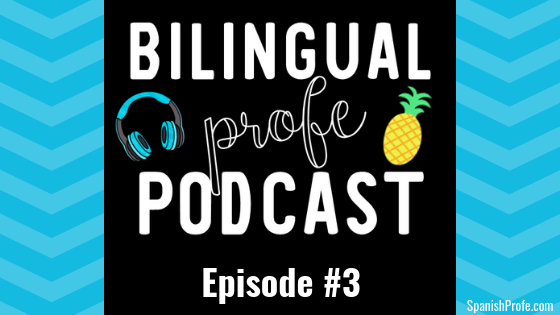
In episode 3, Janet will discuss five tips to be a more productive teacher in the New Year.
Podcast: Download
FULL TRANSCRIPT:
You are listening to the Bilingual Profe Podcast, episode number three. Today, we’ll talk about how to be a more productive teacher in the New Year, so stay tuned. The Bilingual Profe Podcast is for busy bilingual teachers looking to improve their teaching practices and classroom. If you are a bilingual Spanish immersion or dual-language teacher, then this is the podcast for you. We’ll talk tips, ideas, and best practices for your bilingual classroom. Are you one of us? Come join the conversation at bilingualprofe.com. (singing). What’s up, bilingual teachers? This is Janet Jimenez. Thanks for tuning in to this episode of the podcast.
Today, we’ll talk about five tips on how to be a more productive teacher in 2019. Do you ever find yourself going into school really early or staying hours after school gets out to try to finish things? Are you someone that works on your lesson plans and translating resources almost every single night and on weekends? If you answered “yes” to any of those questions, then hopefully this podcast can give you a few ideas on how to use your time more wisely and be more productive. It is important that you get time to take a break, that you get time to spend doing things that you like, and that you are able to spend time with your family and your kids and aren’t always thinking about being a bilingual teacher at all hours of the day. Let’s go through five tips that you can use to help regain your precious free time and get rid of some of your bilingual teacher overwhelm.
Tip number one, batching. No, you aren’t going to make cookies, but batching means preparing multiple sets of something. Instead of each morning going in and making copies of just what you need for that day, what would happen if you batched everything? That would mean that you could make copies or prepare for the entire week or month at one time. I would often do this in my classroom with morning work, or writing papers and prompts, math sheets and worksheets or centers, homework, and book report forms that my students use on a daily basis. Whatever it is that you routinely use over and over again is something that you can batch. You could just take one morning every couple weeks and go in and make a ton of copies, and then you have that prepared and ready to go. Then you won’t be making last-minute copies or running to the copier and then be out of luck when you are absent or, of course, when the copier stops working.
Tip number two, have an organization system in place in your classroom. Behind my desk, I have six book bins and a three-drawer container. For the book bins, I have one for each day of the week, so a Monday bin, a Tuesday bin, a Wednesday bin. You get the picture, and then the sixth bin is for next week, so what I do is put everything I need into each day and then, as I just said, I usually batch things, so in the next week bin, I usually have all of the morning work or writing sheets with a paperclip around each day in that bin. I know that once Friday ends, I just kind of move over and put the next things in Monday, so I’m prepared.
This is really helpful, so I know what’s going on every day, and then especially if you’re absent or something, you usually have, you can just say, refer your substitute to the Monday bin or the Tuesday bin, which is easy. I also have a bin with, or I guess it’s like a paper tray, a tiered paper tray or organizer that I use and that I keep different things in those, so graded papers or papers that I need to hand back, papers that I need to file in portfolios. Also, important papers that I might need for PLCs or meetings, I also keep there, so I have them in a place, easy place of reference that I can grab when I need them. The organization system really helps to keep me on track and know where things are.
Now, I’m not a very organized person, and this system has helped me, so if you are someone like me who tends to have kind of a big mess on your desk or is kind of a procrastinator, I found that having the batching and then putting bins, having one for each day of the week let me plan far in advance and was very helpful in my classroom.
Tip number three, plan as a team. If you’re lucky enough to have a grade-level team to work with, then please use your planning time wisely. For example, during our planning time as a first-grade team, we each would come to our weekly planning meeting with our “I can” or [Spanish 00:05:41] statements ready to go for the following week, and then since there are four of us, we each assigned each other a subject, so one of us would have everything ready and planned for the following week for math, one for reading, one for writing, and then the last person was in charge of social studies, science, and health. This really helps on knowing what we need to do, and once we got there, we could kind of bounce ideas off of each other’s heads, but we were, for the most part, prepared and knew what we were going to be doing the following week without spending time looking at the scope and sequence of the school district or looking in our planning books.
In addition to splitting up subjects, we also had a grade-level team home communication that we had to send home, so every Friday or every Monday, we would send home a bilingual paper, one side English, one side in Spanish, of just announcements and homework that we needed the families to know about. For that, we would, as a team, split that up, so we assigned each other three weeks in a row. I would do three weeks. Then one of my colleagues would do the next three weeks, and then … You get the picture.
I only had to do it every about two to three months. Then the person that was in charge of making the revisions and having that ready would also make copies for each of us, so every, if it was my week, I would revise the document, make sure it was ready for all the families, and then print off a set for each of my colleagues so that it was ready to go and in their boxes by Friday morning. This really helped and saved time, and it was also very nice for families to get a consistent message from all grade-level teachers about what was going on in first grade.
Tip number four, have expectations in your classroom, and hold students accountable for many jobs. Now, I will never forget one teacher I worked with. She would be one of the first people in the building every morning, and after school, the custodians would have to kick her out of the building. She just was there, like at least 12 hours a day, if not longer. She was there for so many hours, and she would always tell me that she wasn’t done, or she didn’t have enough time to finish everything. I’d see her at her prep time putting papers in mailboxes and organizing chairs, and she spent hours a day doing things that her students could have done in minutes with proper training and procedures.
Guys, it doesn’t have to be like that. I think many bilingual teachers, or any teacher, for that matter, might have some control issues, or maybe some perfectionistic tendencies, but you know what? You need to save your time and stop being … Nothing can be really perfect, so just start delegating things to your students. You should have classroom jobs, have parts of your daily routine be housekeeping. Teach your students how to take down and stack chairs, how to clean the floor, vacuum if necessary, how to put papers in mailboxes, how to take them out of mailboxes, how to wipe down desks and tables, and do whatever else is needed in the classroom.
You should not be wasting your time, your precious time, doing menial tasks, when you could be teaching your students and your classroom valuable lesson. Make sure to give your students the power to take care of their classroom, and they will love it. Well, some will love it more than others, and it will save you time, and you’ll be able to do more important things.
Tip number five, ask for help from parents. Now, many parents are willing to come in for 30 minutes to an hour, so a week, or even do things at home. Be sure to send home a volunteer sheet or questionnaire asking parents what they’re interested in doing or if they’re interested in doing anything, and you’d be surprised how much some parents are willing to help you. Lots of parents will do a wide variety of things. I’ve had parents put labels on things, put bulletin board papers up, take them down, stuff folders, clean out lockers. Let’s see, what else? Cut out laminating. Just anything. Lots of people are willing and able to do that. Sharpen pencils, organize a classroom library. There are so many options, and if you don’t ask, then you’ll have to do it. If you ask for help, most likely you will find one or many willing parents that are willing to help out in the classroom.
Let’s review the five tips that we talked about today that will help you stay more organized and help you save time in 2019. Tip number one was batching. Tip number two was, create an organizational system. Tip number three, plan productively as a team. Tip number four, have students help maintain your classroom. Tip number five, ask parents for help. Do you have any other ideas? Head over to our website and let us know how you save time in your bilingual classroom. I’m sure your ideas will save others a ton of time. Thanks for listening. Thanks for tuning in. If you are a busy bilingual profe, I’d love to hear from you. Head over to bilingualprofe.com to connect with other bilingual educators just like you. See you next time. Bye bye. (singing).
Enjoy the podcast! We hope it gives you some ideas for your Bilingual classroom.
Feeling stressed? Want instant access to all to over 300 resources in Spanish for Pre-K through 2nd grade bilingual and Spanish immersion teachers for less than $1/day? Join Profe Club. Use code ‘podcast’ at checkout to get a 25% discount.










